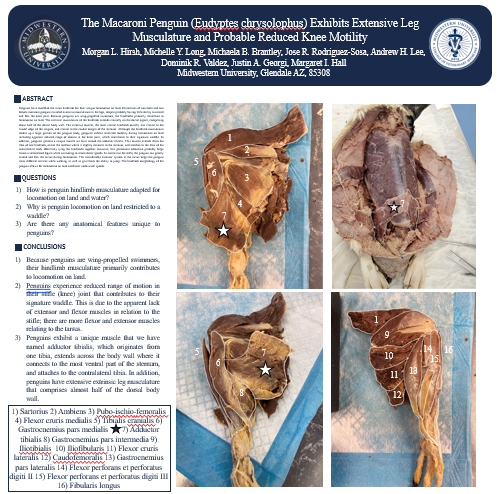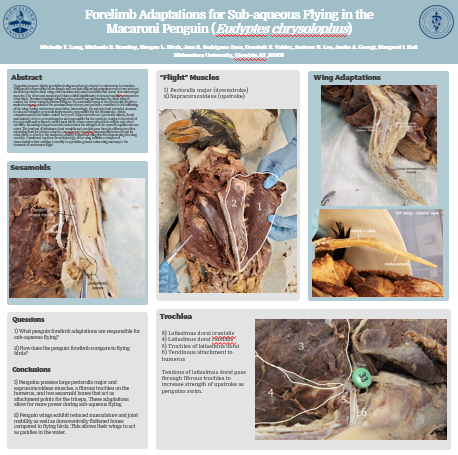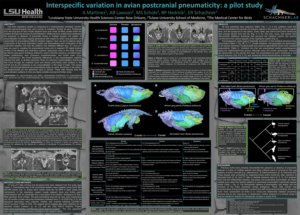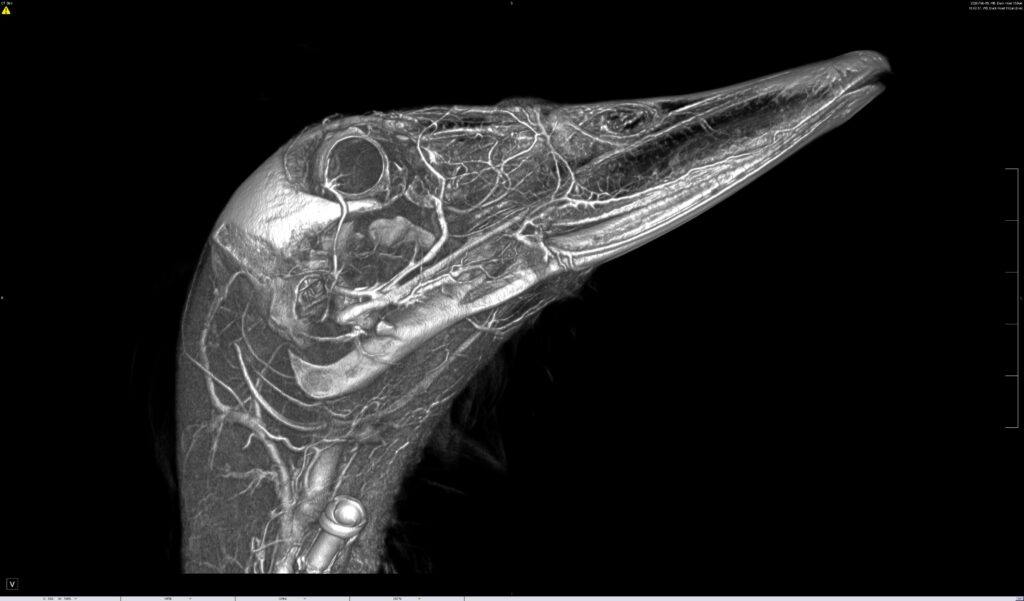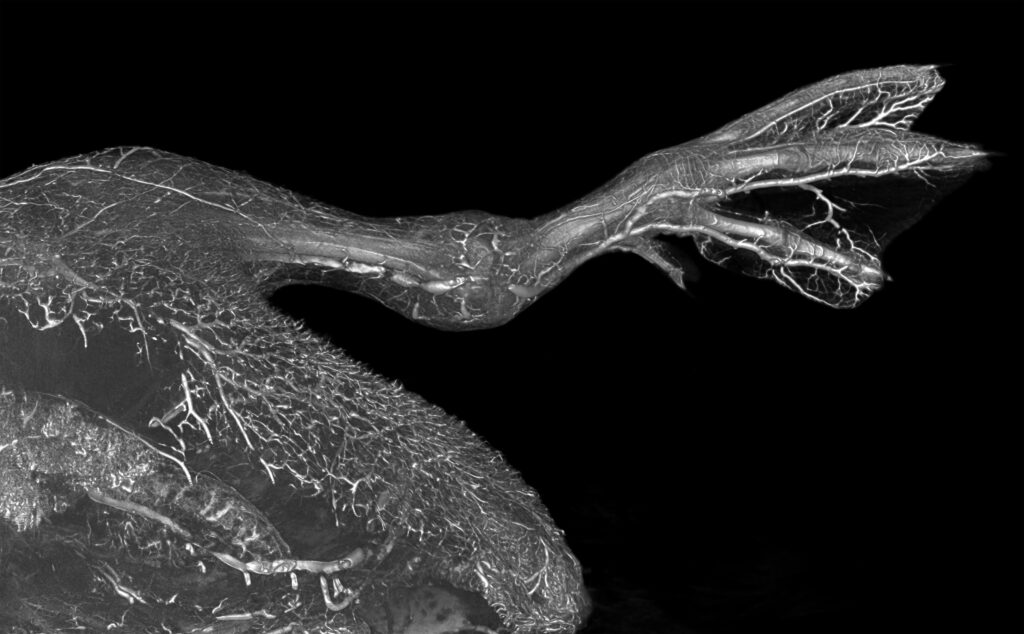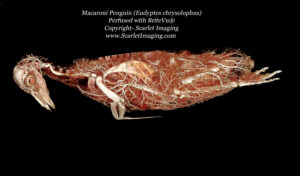Grey Parrot Anatomic Study
Project Title: Grey Parrot Anatomic Study
Start Date: 2013
Lead Researcher(s): Dr. Scott Echols, Dr. Mark Nielsen and Dr. Shawn Miller
Contributing Researchers: Scott Birch, Dr. Casey Holliday, Dr. Jeremy Klinger, Dr. Ashlee Mooney, Dr. Susan Orosz, Dr. Emma Schachner, Dr. Nico Schoemaker, Dr. Brian Speer, Dr. Henry Tsai, Dr. Yvonne van Zeeland
Project Purpose: To define, in detail, the anatomy of the grey parrot (Psittacus erithacus) and create publicly available publications. The information gained from this study can be used to set standard nomenclature for anatomic terms and advance the study of other avian species. This is the original study that started multitudes of research projects in other animals.
Funding Needed: We are using general funds (any donation benefits this study) to collect grey parrots as they become available.
Special Notes: Countless veterinarians, companion bird owners, researchers, interested public and more have contributed to this project by donating their time, money, patients and personal companions. Without the efforts of so many interested people, the Grey Parrot Anatomic Study would not be possible. We are still accepting grey parrots for this study. Thank you!
Publications Produced:
Gignac PM, Kley NJ, Clarke JA, Echols MS, et al. Diffusible iodine-based contrast-enhanced computed tomography (dice-CT): an emerging tool for rapid, high resolution, 3-D imaging of metazoan soft tissues. J of Anatomy. 2016;228(6):889–909.
Cost IN, Middleton KM, Witmer LM, Echols MS, Holliday CM. Comparative anatomy and biomechanics of the feeding apparatus of parrots (Aves: Psittaciformes). Poster presentation. Experimental Biology. April, 2017.
Lawson AB, Echols MS, Schachner ER. Anatomy of the respiratory system of the African grey parrot (Psittacus erithacus). Poster. Experimental Biology. April 24, 2018.
Cost IN, Middleton KM, Sellers KC, Echols, MS et al. Palatal Biomechanics and Its Significance for Cranial Kinesis in Tyrannosaurus rex. The Anatomical Record 2020, 303:999–1017. DOI: 10.1002/ar.24219.
Orosz SE, Echols MS. The urinary and osmoregulatory system of birds. Vet Clin N Am Exot Anim Pract. Vet Clin Exot Anim 23 (2020) 1–19.
Lawson AB, Hedrick BP, Echols S, Schachner ER. Anatomy, variation, and asymmetry of the bronchial tree in the African grey parrot (Psittacus erithacus). J Morphology. March, 2021. https://doi.org/10.1002/jmor.21340
Martinez A, Lawson AB, Echols MS, Hedrick BP, Schachner ER. Interspecific variation in avian postcranial pneumaticity: a pilot study. Experimental Biology, 2022. Philadelphia, PA.
Lessner EJ, Echols MS, Paul-Murphy JR, Speer BL, Holliday CM. Grey parrot (Psittacus erithacus) beak papillae and nerves identified using novel 2-D and 3-D imaging modalities. AJVR, 2023. https://avmajournals.avma.org/view/journals/ajvr/aop/ajvr.23.03.0059/ajvr.23.03.0059.xml
Schachner ER, Lawson AB, Martinez A, Grand Pre CA, Sabottke C, Abou-Issa F, Echols S, Diaz Jr RE, Moore AJ, Grenier J-P, Hedrick BP, Spieler B. Perspectives on lung visualization: Three-dimensional anatomical modeling of computed and micro-computed tomographic data in comparative evolutionary morphology and medicine with applications for COVID-19. Anatomical Record. 2023. http://doi.org/10.1002/ar.25300
Martinez A, Hedrick BP, Diaz RE, Schachner ER. Pulmonary anatomy of the zebra finch (Taeniopygia guttata) and interspecific comparison with the ostrich (Struthio camelus) and African grey parrot (Psittacus erithacus). American Association of Anatomy Annual Conference, Washington DC, 2023.
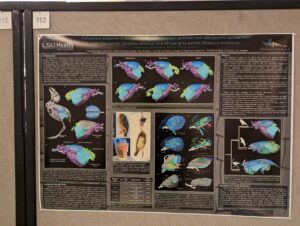
Feeding Mechanisms of Nectar Feeding Birds
Project Title: Feeding mechanisms of nectar feeding birds
Start Date: 2019
Lead Researcher(s): Dr. Alejo Rico-Guevara, Dr. Scott Echols, Dr. Maude Baldwin and Dr. Mitzi Klein
Contributing Researchers: Dr. Bill A Buttemer, Dr. Pat MacWhirter, Tracy Aviary
Project Purpose: To define, in detail, the anatomy of the feeding mechanism of birds that drink nectar. This includes hummingbirds to lories and will also include comparative studies of non-nectar feeding birds. This study is also intended to be an introductory study to Australian animals (birds, reptiles and mammals) to be studied at the Australian Synchotron.
Funding Needed: To be determined.
Special Notes: We are currently considering animal donations for this project and are especially interested in Australian species.
Publications Produced: Not at this time.
Leg Anatomy of the Domestic Duck
Project Title: Leg Anatomy of the Domestic duck
Start Date: 2019
Lead Researcher(s): Dr. Henry Tsai and Dr. Scott Echols
Contributing Researchers: To be determined.
Project Purpose: To define, in detail, the anatomy of the domestic duck leg. Focus will be given to musculoskeletal, tendonous and ligamentous anatomy. Domestic ducks are plagued with arthritis, bumblefoot and leg infections. This study is in effort to better define the anatomy for improved medical and surgical treatments.
Funding Needed: $18,926.50
Special Notes: We plan to start more intensive study in late 2020.
Publications Produced: Not at this time.
Penguin Anatomy Study
Project Title: Penguin Anatomy Study
Start Date: 2021
Lead Researcher(s): Drs. Scott Echols, Meg Hall and Carrie Veilleux
Contributing Researchers: Justin Georgi, Chris Heesy, Andrew Lee, Emma Schachner, Erin Simons and Heather Smith
Project Purposes: 1. To define and publish the anatomy of several penguin species. At current time, we have a male and female Macaroni penguin (Eudyptes chrysolophus). 2. Utilize CT scan data to describe the lower respiratory system.
Funding Needed: Not determined yet.
Special Notes: The primary study involves documenting the anatomy of multiple penguin species. Additionally, special studies will be conducted on the respiratory system, eyes and more. We are expecting to get penguins from 4-7 different species over a 2-3 year period of time.
Publications Produced: Not at this time.
